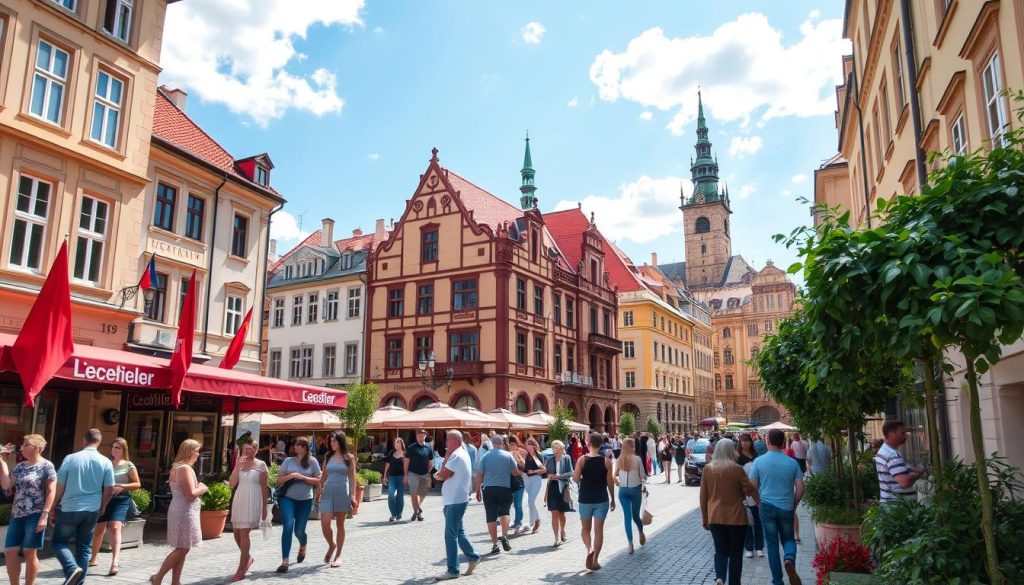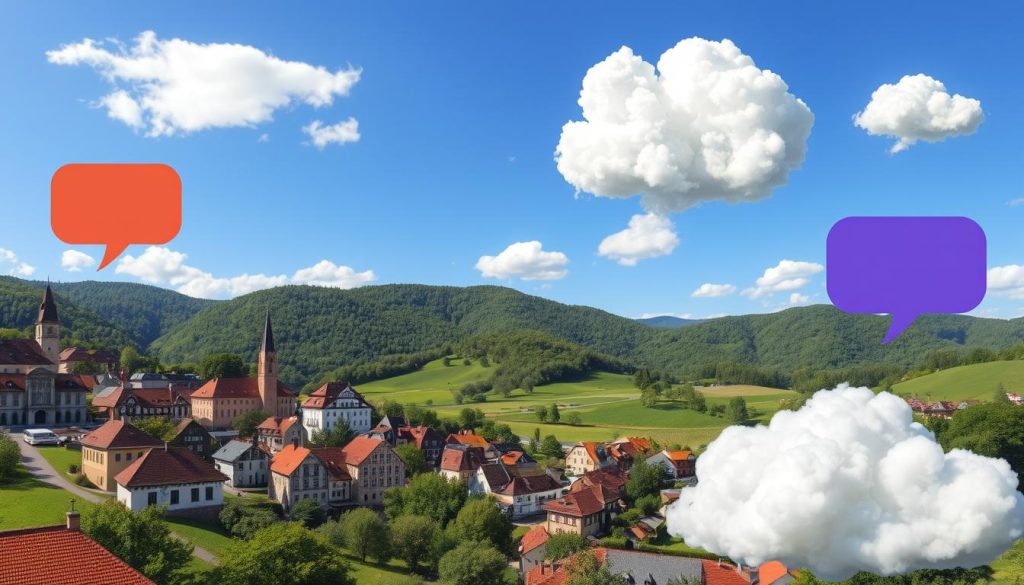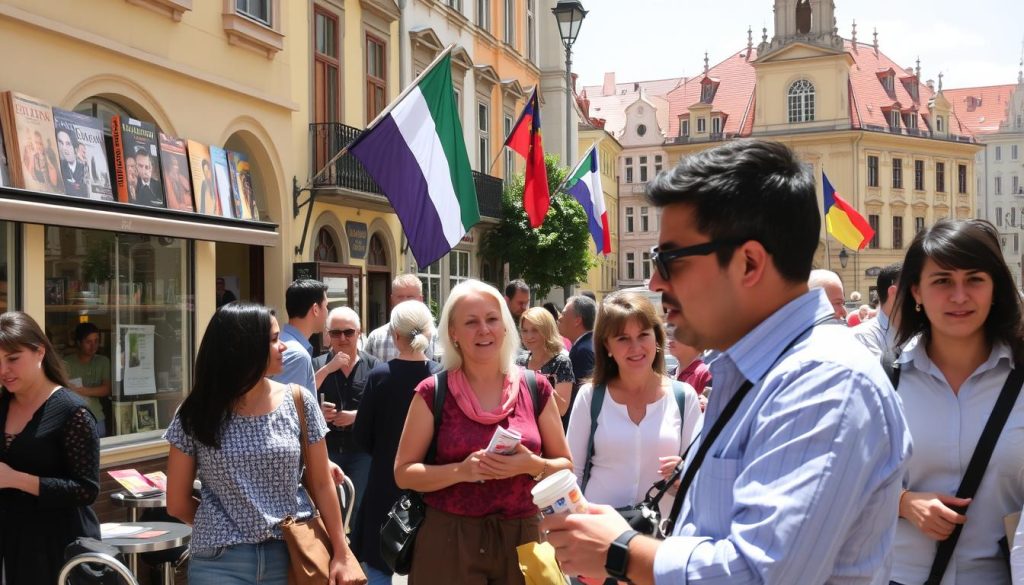Ever wondered how a small Central European nation stays so united in language? In Czechia, the Czech language is the key, creating a unique linguistic scene. It deeply connects with the nation’s identity.
Czechia is right in Europe’s heart, with a strong language profile. The Czech language is more than just a way to talk; it’s a cultural base. About 98% of people speak it, showing strong national language pride.
In Prague’s old streets and Moravia’s countryside, Czech language fills the air. Its history and special traits make it a treasure for language lovers everywhere.
Key Takeaways
- Czech is the official language in Czechia, spoken by 96-98% of the population
- Approximately 10.6 million people speak Czech as their primary language
- The language belongs to the Western Slavic language group
- Czech has been recognized as an official European Union language since 2004
- The language features a complex grammatical structure with 32 letters in its alphabet
Overview of Language Landscape in Czechia
Czechia is a unique place in Central Europe, where many languages meet. This shows the country’s deep cultural and historical roots. With about 10.6 million people, Czechia’s language scene is quite diverse.
Current Language Demographics
The Czech language is spoken by 96% of the people here. But Czechia is also home to many other languages. This makes its language scene very rich and diverse.
- Czech: Primary language (96% of population)
- Slovak: Widely understood due to shared historical ties
- German: Significant minority language
- Polish: Regional language presence
- Romany: Minority language group
Historical Language Evolution
The history of Czechia’s languages is complex and fascinating. The West Slavic languages, like Czech, Polish, and Slovak, have a long history here. They are deeply rooted in the region’s culture.
*”Language is the road map of a culture. It tells you where its people come from and where they are going.”* – Rita Mae Brown
Geographic Distribution of Languages
| Region | Primary Languages | Cultural Significance |
|---|---|---|
| Bohemia | Czech, German | Historical cultural center |
| Moravia | Czech, Moravian Dialect | Rich linguistic variations |
| Czech Silesia | Czech, Polish | Multicultural border region |
Exploring Czechia’s languages helps us understand its rich culture. Language is a key part of the country’s history and ongoing cultural exchanges.
Czech as the Official State Language

The Czech language is the official language of Czechia. It is deeply connected to the nation’s culture and government. It is the main way 89% of the population communicates.
Understanding the official language status of Czech reveals several key insights:
- Czech is the primary language in government, legal, and educational systems
- It is recognized as an official language within the European Union
- The language plays a crucial role in national identity and communication
The legal framework makes Czech important in public life. All government documents and educational materials are in Czech. This keeps the language and culture strong.
“Language is the road map of a culture. It tells you where its people come from and where they are going.” – Rita Mae Brown
Czechia values its language, even with other languages around. International groups use “Czechia” in their work. This shows the language’s importance worldwide.
The country’s love for its language goes beyond its borders. The State Language Act of 1995 sets rules for using Czech. This shows respect for the language’s heritage.
Historical Development of Czech Language
The Czech language has a long and interesting history. It is a key part of the Slavic languages. It has changed a lot from its early days to what we know today.
The story of the Czech language is one of cultural strength and new ideas. It has faced many challenges over the years. Yet, it has always found a way to adapt and grow.
Medieval Period Development
In the medieval times, Czech started to form as its own Slavic language. Important changes included:
- It came from West Slavic roots
- First written records were from the 12th-13th centuries
- Phonological changes happened between the 12th and 13th centuries
Modern Czech Formation
The Czech language changed a lot during important times. Cultural and political changes played big roles in these changes.
“Language is the road map of a culture. It tells you where its people come from and where they are going.” – Rita Mae Brown
Standardization Process
Standardizing Czech was a careful and planned effort. Important steps were:
- Introduction of diacritic orthography around 1406
- Publication of the Bible of Kralice (1579-1593)
- National revival movement in the 19th century
| Period | Linguistic Characteristics |
|---|---|
| 12th-13th Centuries | Initial written records emerge |
| 14th Century | Cultural development under Emperor Charles IV |
| 19th Century | National revival increases language prominence |
Today, Czech is a symbol of language strength. It has about ten million speakers. It also has a deep history in the Slavic language family.
Czech Language Classification and Structure

The Czech language is a key part of the Slavic languages family. It belongs to the West Slavic branch. Its unique structure shows a deep connection to Central European communication.
Exploring the Czech language, you’ll find many special traits. These traits make it different from other Slavic languages:
- Written in Latin script
- Part of the Czech-Slovak language group
- Complex grammatical structures
- Intricate phonological systems
The roots of the Czech language go back to medieval times. It has grown through many cultural and historical changes. Its grammar is complex, with:
- Seven grammatical cases
- Many verb conjugations
- Complex noun declension systems
- Clear word order rules
“Czech represents a linguistic treasure within the Slavic languages, reflecting centuries of cultural evolution.”
Linguists see Czech as a West Slavic language. It’s similar to Slovak, Polish, and Sorbian languages. Its structure allows for detailed expression, making it a powerful tool for over 10 million speakers.
Getting to know the Czech language means understanding its complex grammar. It’s a key part of the Slavic language family’s rich heritage.
German Language Influence in Czechia
The German language has deeply influenced Czechia’s language scene. This is due to political rule and cultural exchange. German has been a key player in the area’s language mix.
Historical German Presence
During the Habsburg era, German became the top language used by rulers. This changed Czechia’s language scene a lot. Some important events include:
- Political enforcement of German by rulers like Ferdinand II
- Marginalization of the Czech language to dialect status
- Compulsory German communication for peasants and workers
Modern German Usage
Today, German still has a big role in Czechia’s language scene. Let’s look at its current state:
| Year | German Citizens in Czech Republic | Population Change |
|---|---|---|
| 1994 | 4,195 | Initial baseline |
| 2010 | 13,871 | 93.0% increase |
| 2022 | 14,032 | Slight growth |
Business and Tourism Impact
Knowing German is still important in Czechia’s economy and tourism. Places like Karlovy Vary and Prague have many German speakers. This helps with business and cultural exchanges.
German linguistic influence continues to be a testament to the interconnected history of Central European nations.
Seeing how German has shaped Czechia’s language and culture is enlightening. It shows the rich diversity and history of the region.
Slovak Language Usage and Mutual Intelligibility
The Czech and Slovak languages show a unique bond in Slavic languages. They share a deep history and are part of a dialect continuum. This connection is fascinating.
People speaking Czech and Slovak can usually understand each other well. This is because they come from the same Proto-Slavic language. Early Slavic tribes in Central Europe spoke this language.
“Where there’s a will, there’s a way” – a proverb that resonates identically in both Czech and Slovak languages.
- Approximately 5 million native Slovak speakers
- High mutual comprehension between Czech and Slovak
- Recognized as a minority language in multiple European countries
Czech and Slovak have small but interesting differences. They both use a Latin-based alphabet with special marks. But, they sound and structure words differently.
Slovak keeps more old-fashioned grammar than Czech. This shows how languages can change over time.
| Language Characteristic | Czech | Slovak |
|---|---|---|
| Unique Phonemes | ř, ě, ů | ä, ľ, ĺ, ŕ, ô |
| Vowel Phonemes | 10 | 15 (including diphthongs) |
| Grammatical Structure | More evolved | More conservative |
Before 1993, Czech and Slovak were used equally on TV and radio. This shows their strong connection in language and culture.
Learning about Czech and Slovak languages gives us a peek into Central Europe’s rich language diversity.
Moravian and Silesian Dialects
The Czech language is full of life, thanks to the Moravian and Silesian dialects. These dialects show the amazing variety of languages in the Czech Republic. They give us a peek into the unique cultures of different regions.
Regional Dialect Variations
Moravian dialects are a treasure trove of language. The Czech Republic has five main dialect groups. Moravian dialects are special because of their own sounds and grammar.
- Eastern Moravian (Moravian-Slovak)
- Central Moravian (Hanakian)
- Silesian (Lach)
Cultural Significance
These dialects are more than just language. They are a living part of the culture. Each dialect holds stories, traditions, and community spirit passed down through generations.
“Language is the road map of a culture. It tells you where its people come from and where they are going.” – Rita Mae Brown
Contemporary Usage
Even though dialect use is decreasing, about 108,000 people still speak Moravian dialects. Cities like Brno and Olomouc, and areas in Vysočina, keep these traditions alive.
| Dialect Group | Primary Regions | Distinctive Features |
|---|---|---|
| Eastern Moravian | Zlín Region | Slovak language influences |
| Central Moravian | Olomouc | Unique phonetic variations |
| Silesian | Moravian-Silesian Region | Polish linguistic influences |
Learning about these dialects shows us the rich and lively nature of the Czech language.
English Language Influence in Czechia

In Central Europe, Czechia is seeing a big change in languages. English is becoming more popular, especially among the young and in cities.
Looking into Czechia’s language scene shows an interesting mix. English is now key in many areas:
- Professional environments
- Higher education institutions
- International business networks
- Technology and startup ecosystems
Even though Czech is still the main language, more people are learning English. Young professionals and students are quickly picking up English. They do this without losing their cultural heritage.
“English acts as a bridge, connecting Czechia to global opportunities without eroding local cultural identity.”
The language scene in Czechia is very flexible. English is now a big focus in schools. Many start learning English early on.
| Language Context | English Influence |
|---|---|
| Business Communication | High Integration |
| Academic Settings | Increasing Importance |
| Urban Professional Environments | Significant Presence |
Understanding Czechia’s language diversity shows a smart way of adopting languages. English is seen as a helpful tool. It makes communication better while keeping Czechia’s language traditions alive.
Minority Languages and Their Status
Czechia is home to a rich mix of languages, beyond just Czech. The country values many minority languages. These languages show the complex culture and history of Czechia and its neighbors.
There are many minority languages in Czechia, each with its own story and importance. Let’s look at some of the most notable ones:
Polish Communities
About 50,000 Polish speakers live in Czechia. Most of them are in the Těšín Silesia area. Their language enriches the country’s cultural mix.
Romany Language Groups
The Romany community in Czechia is diverse. There are between 40,000 to 200,000 Romani speakers. They are a big part of the country’s linguistic heritage.
Other Recognized Minorities
Czechia also has other minority languages:
- Ukrainian speakers (approximately 200,000)
- Vietnamese nationals (over 80,000)
- German speakers (around 40,000)
- Hungarian speakers (about 0.13% of population)
| Minority Language | Estimated Speakers | Population Percentage |
|---|---|---|
| Polish | 50,000 | 0.4% |
| Romany | 40,000-200,000 | 0.4-2% |
| Ukrainian | 200,000 | 2% |
| Vietnamese | 80,000 | 1% |
In 2000, the Czech Republic joined the European Charter for Regional or Minority Languages. This shows its dedication to keeping languages alive and protecting minority rights.
“Language is the road map of a culture. It tells you where its people come from and where they are going.” – Rita Mae Brown
Language Education and Policy
In Czechia, language education is highly valued. The Czech language is key in schools. Since 2007, the Framework Education Programme for Basic Education (FEP BE) has led language teaching.

The curriculum sets aside time for learning languages. It focuses on Czech and foreign languages. Here’s a look at the language education priorities:
- Czech Language and Literature: 35 hours in the first stage, 15 hours in the second stage
- First Foreign Language: 9 hours (1st stage), 12 hours (2nd stage)
- Second Foreign Language: 6 hours in the second stage
Language education in Czechia is more than just learning. It aims to keep the language alive and ready students for the world. The revised FEP BE, published in 2021, ensures that schools adapt their educational programs to meet modern language learning needs.
“Language is the road map of a culture. It tells you where its people come from and where they are going.” – Rita Mae Brown
Key points of Czech language education policy are:
- Comprehensive coverage of Czech as the official language
- Strong support for multilingual education
- Flexibility in curriculum implementation
- Focus on preserving linguistic diversity
| Language Education Stage | Total Compulsory Hours | Language Focus |
|---|---|---|
| First Stage (Years 1-5) | 118 hours | Czech and Initial Foreign Language |
| Second Stage (Years 6-9) | 122 hours | Advanced Czech and Multiple Foreign Languages |
About 96% of people in Czechia speak Czech. The language education policy helps keep this strong. It also prepares them for global communication.
Impact of EU Membership on Language Diversity
When Czechia joined the European Union in 2004, a new era of linguistic opportunities emerged. The country’s linguistic diversity got a big boost from EU membership. This changed how people interact and exchange cultures.
The EU’s language policy has deeply influenced Czechia’s language scene. Czech became one of the 24 official EU languages. This recognition opened up great opportunities for Czech speakers in European institutions and countries.
- Czech became an official EU working language
- Increased mobility for Czech professionals
- Enhanced language learning programs
- Greater cultural exchange opportunities
EU policies push for multilingualism, encouraging people to learn many languages. For Czechia, this led to big investments in language education and strategies for cross-border communication.
| Language Metric | Pre-EU Membership | Post-EU Membership |
|---|---|---|
| Foreign Language Proficiency | 35.4% knew no foreign languages | 64.6% now know at least one foreign language |
| International Work Opportunities | Limited | Significantly expanded |
| Cultural Exchange Programs | Restricted | Numerous EU-sponsored initiatives |
The linguistic diversity in Czechia has become more dynamic and interconnected. English, German, and other European languages now blend together more smoothly. This shows the country’s evolving multilingual identity.
“Language is the roadmap of a culture. It tells you where its people come from and where they are going.” – Rita Mae Brown
As Czechia keeps embracing its EU membership, language diversity stays a key tool for cultural understanding and international collaboration.
Conclusion
Your journey through Czechia’s language shows a complex and lively scene. The Czech language is more than a way to talk; it’s a symbol of the nation’s deep culture. It shows the country’s history and identity through words.
In Czechia, you find a mix of dialects and influences from other languages. This mix shows the country’s history, from old kingdoms to today’s state. Knowing about these languages helps us understand Czechia’s culture and society better.
Czechia’s language is changing in the 21st century. It blends old Czech traditions with new global trends. This mix makes the language exciting and shows how it connects people through time and space.
If you love languages, culture, or just want to learn about Czechia, this journey is for you. It opens a door to the heart of a nation, showing its rich language heritage. The Czech language is a key part of Czech identity, always changing yet keeping its deep history.
The above is subject to change.
Check back often to TRAVEL.COM for the latest travel tips and deals.
Here are some Tours & Sightseeing suggestions that might pique your interests!
